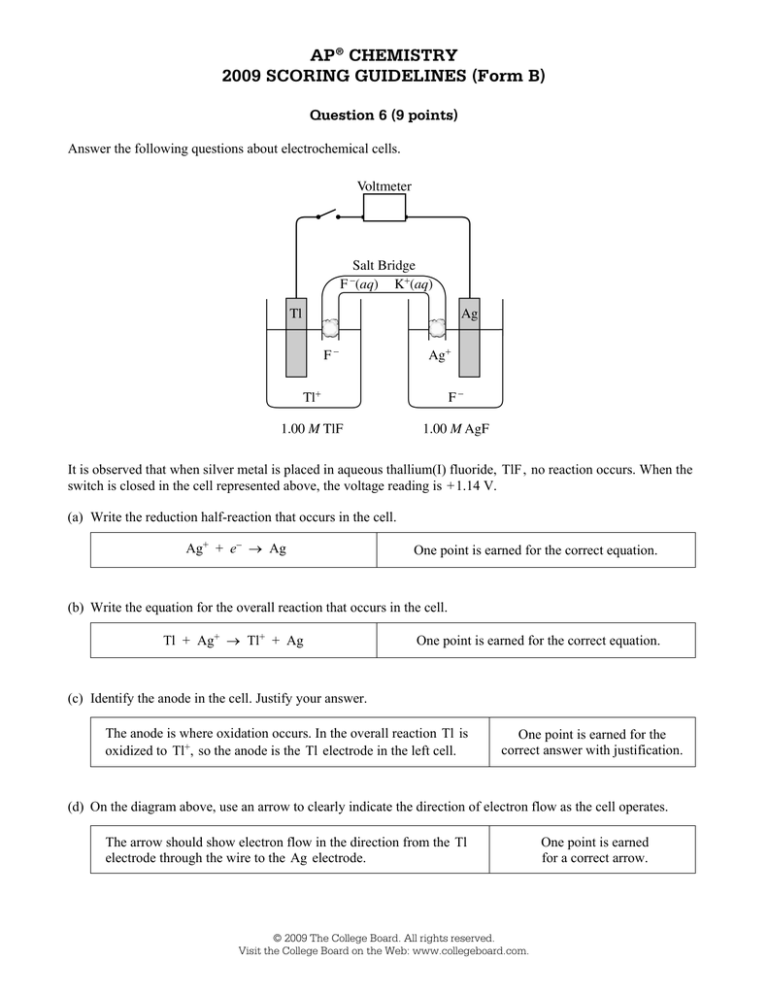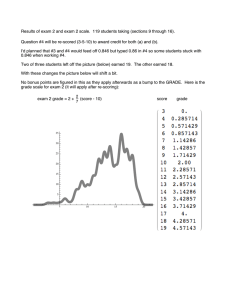
AP® CHEMISTRY
2009 SCORING GUIDELINES (Form B)
Question 6 (9 points)
Answer the following questions about electrochemical cells.
It is observed that when silver metal is placed in aqueous thallium(I) fluoride, TlF, no reaction occurs. When the
switch is closed in the cell represented above, the voltage reading is +1.14 V.
(a) Write the reduction half-reaction that occurs in the cell.
Ag+ + e− → Ag
One point is earned for the correct equation.
(b) Write the equation for the overall reaction that occurs in the cell.
Tl + Ag+ → Tl+ + Ag
One point is earned for the correct equation.
(c) Identify the anode in the cell. Justify your answer.
The anode is where oxidation occurs. In the overall reaction Tl is
oxidized to Tl+, so the anode is the Tl electrode in the left cell.
One point is earned for the
correct answer with justification.
(d) On the diagram above, use an arrow to clearly indicate the direction of electron flow as the cell operates.
The arrow should show electron flow in the direction from the Tl
electrode through the wire to the Ag electrode.
© 2009 The College Board. All rights reserved.
Visit the College Board on the Web: www.collegeboard.com.
One point is earned
for a correct arrow.
AP® CHEMISTRY
2009 SCORING GUIDELINES (Form B)
Question 6 (continued)
(e) Calculate the value of the standard reduction potential for the Tl+/Tl half-reaction.
D = ED − ED
Ecell
red
ox
One point is earned for the correct setup.
D
+1.14 V = +0.80V − Eox
One point is earned for the correct answer.
D = −0.34 V
Eox
The standard reduction potential, E° , of the reaction Pt2+ + 2 e− → Pt is 1.20 V.
(f) Assume that electrodes of pure Pt, Ag, and Ni are available as well as 1.00 M solutions of their salts. Three
different electrochemical cells can be constructed using these materials. Identify the two metals that when
used to make an electrochemical cell would produce the cell with the largest voltage. Explain how you arrived
at your answer.
E°(V)
Ni2+ + 2 e− → Ni
Ag+ + e−
→ Ag
Pt2+ + 2 e− →
Pt
−0.25
0.80
1.20
D = ED − ED
Ecell
red
ox
D
The two metals that yield the largest Ecell
One point is earned for the
correct answer with justification.
are those with the biggest difference in E°,
D calculation
namely, Pt and Ni (see Ecell
below).
D = +1.20 − (−0.25) = +1.45 V
Ecell
(g) Predict whether Pt metal will react when it is placed in 1.00 M AgNO3(aq). Justify your answer.
When Pt metal is added to 1.00 M AgNO3 , the only redox
reaction that could occur would be for Pt to become oxidized
as Ag+ is reduced.
D
D
D
Ecell
= Ered
− Eox
= +0.80 V − (+1.20 V) = −0.40 V
Because
occur.
D
Ecell
for that reaction is negative, no reaction will
One point is earned
for comparing E° values.
One point is earned for
the correct interpretation.
© 2009 The College Board. All rights reserved.
Visit the College Board on the Web: www.collegeboard.com.
© 2009 The College Board. All rights reserved.
Visit the College Board on the Web: www.collegeboard.com.
© 2009 The College Board. All rights reserved.
Visit the College Board on the Web: www.collegeboard.com.
© 2009 The College Board. All rights reserved.
Visit the College Board on the Web: www.collegeboard.com.
© 2009 The College Board. All rights reserved.
Visit the College Board on the Web: www.collegeboard.com.
© 2009 The College Board. All rights reserved.
Visit the College Board on the Web: www.collegeboard.com.
© 2009 The College Board. All rights reserved.
Visit the College Board on the Web: www.collegeboard.com.
AP® CHEMISTRY
2009 SCORING COMMENTARY (Form B)
Question 6
Sample: 6A
Score: 9
This response earned all 9 points: 1 for part (a), 1 for part (b), 1 for part (c), 1 for part (d), 2 for part (e), 1 for
part (f), and 2 for part (g).
Sample: 6B
Score: 6
This response earned 6 of the possible 9 points. In part (a) 1 point was earned for correctly writing the reduction
half-reaction. In part (b) 1 point was earned for correctly writing the overall redox reaction. In part (c) the
response incorrectly identifies the anode and consequently did not earn the point. In part (d) 1 point was earned
for indication of the direction of electron flow consistent with the reactions given in parts (a) and (b). In part (e)
2 points were earned for the correct calculation of the reduction potential of thallium ion with the correct sign. In
part (f) 1 point was earned for identifying the correct metal pair along with a reasonable justification. In part (g)
neither point was earned because the response uses incorrect reasoning and makes the wrong prediction.
Sample: 6C
Score: 3
This response earned 3 of the possible 9 points. In part (a) 1 point was earned for correctly writing the reduction
half-reaction. In part (b) 1 point was earned for correctly writing the overall redox reaction. In part (c) 1 point was
earned for correctly identifying the anode with justification. In part (d) the point was not earned because the
response shows an incorrect direction of electron flow on the diagram. In part (e) no points were earned because
the calculation and answer are incorrect. In part (f) although the response identifies the correct metal pair, the
justification is incorrect, and the point was not earned. In part (g) no points were earned because the explanation is
incorrect.
© 2009 The College Board. All rights reserved.
Visit the College Board on the Web: www.collegeboard.com.

